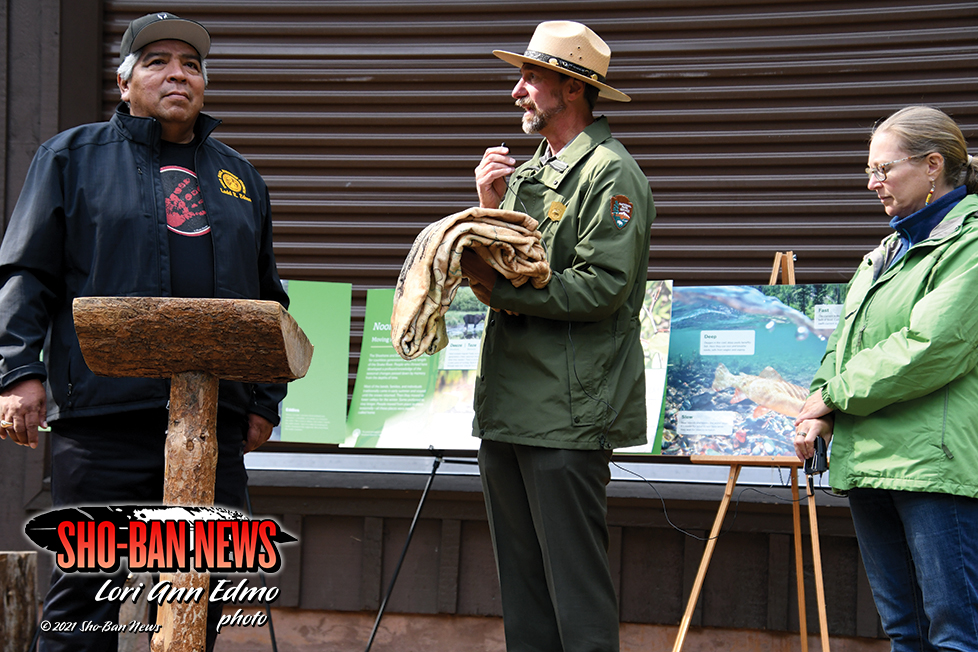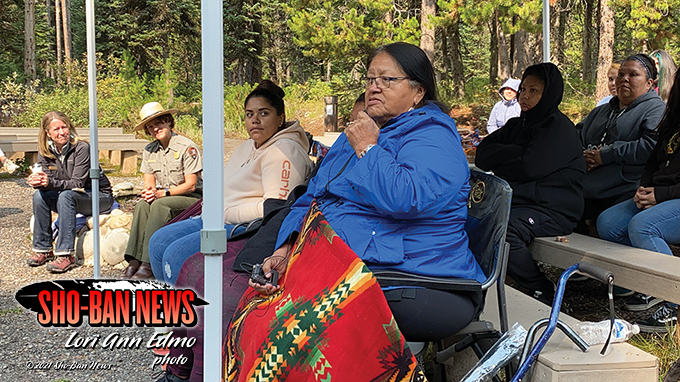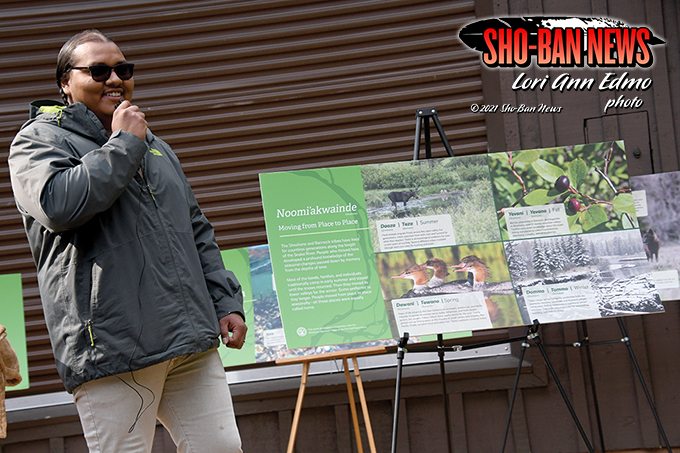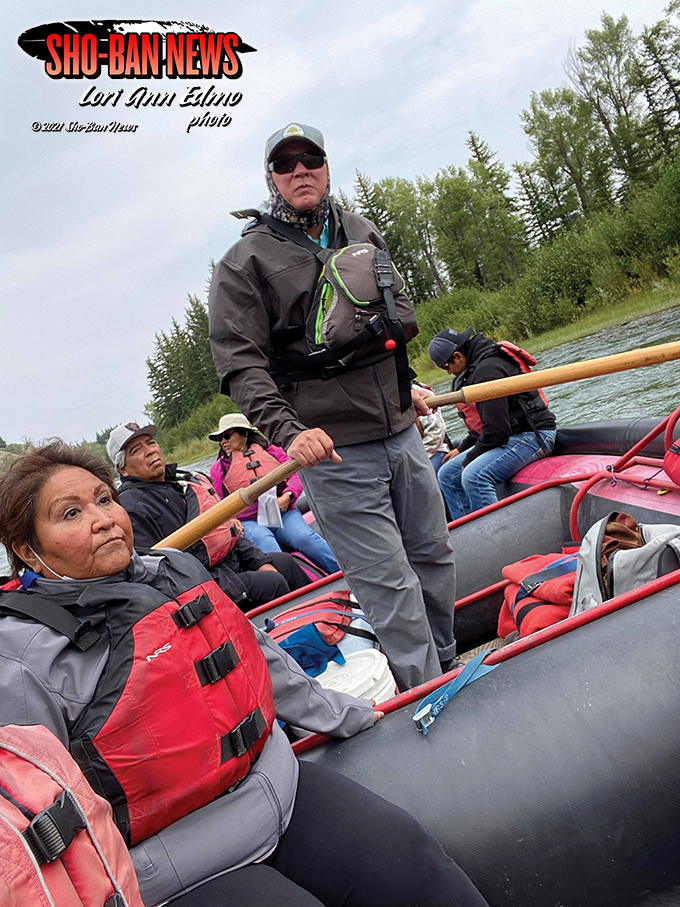Grand Teton NPS working to tell history of original people

FHBC Council Member Ladd Edmo looks on as Grand Teton National Park Superintendent Chip Jenkins speaks.
By LORI ANN EDMO
Sho-Ban News
COLTER BAY, Wyo. — Grand Teton National Park Superintendent Chip Jenkins said the community of Jackson does a really good job in telling part of the story of the last 150 years but what has to be improved upon is the human story including the heritage and history of the original people who occupied it.
Jenkins was addressing those in attendance August 21 at the dedication of interpretive signs Grand Teton National Park staff worked on with the Shoshone-Bannock Tribes Language & Culture Preservation Department for the Pacific Creek Landing area to educate and inform the Park’s approximate four million visitors per year.
“We are deeply honored to have tribal leadership, tribal elders, various committees to be here today,” Jenkins said. “I arrived here a few months ago from the Pacific Northwest, in coming here I noticed the community of Jackson does a really good job in telling part of the story of the last 150 years, but what we don’t do and what we need to improve is to talk about the human story over the last nine or 10,000 years, including talking about the heritage and history of the people who this is their homeland and continue to be your homeland with a vibrant and active culture.”
He talked about the collaboration with the Tribes to help them understand how “you want us to tell the story, how you want us to be able to inform people who come here from all over the country about this place and your history.” It is his sincere hope it is the start not the end to do more work. Jenkins said Pacific Creek is the first of the boat launches they are working on. “There are four or five more but we are also hoping work in our visitors centers in our education and interpretation program, in our publications, our digital media we will be able to continue to find ways to collaborate with the tribe to be able to be able to accurately and appropriately to reflect the stories you would like us to share with millions of people a year.”

LCPD Cultural Resources Director Louise Dixey speaks.
Fort Hall Business Council member Ladd Edmo thanked the NPS for preserving and protecting, “our natural resources, we like to come and gather and see what’s available to us.” He explained the Shoshone-Bannock Tribes are 6,087 members strong and are a treaty tribe so when the reservation was established it was 1.8 million acres and out of that over 500,000 acres remain. He noted some of the lands were ceded for good reason – a lot of the municipalities around the area are on ceded lands. “We are willing to cooperate and communicate with our neighbors,” Edmo continued. He thanked the Language and Culture Department as what he sees is the Park Service provides opportunities. He appreciated the campgrounds that had designated areas for groups, hikers, bikers, RVs and regular family campsites.
“This is a magnificent place,” he continued. “I would like to say where the Snake River starts maybe this is the heart of that river, it flows downstream all the way down into the Columbia River and into the ocean. From here to there what brings to my mind is where pure and clean water is right now, as it hits each city, community, so on and so forth,” the dams, it controls and keeps the river from flooding, for a purpose — for irrigation, water users, those things are okay but sometimes we disrupt the natural flow, it causes repercussions, there may be changes or things we can’t understand,” Edmo said as leaders they learn about a lot of things and working with the NPS, they’ve made some agreements. He appreciates being able to use his tribal identification card for entry into the park, along with for campsites. “I hope you all enjoy,” he said.
Researcher Nolan Brown of the Tribes LCPD Original Territories office helped create the interpretive panel for the Pacific Creek Landing. He read the first panel and said “Noomi’awwainde” interprets moving from place to place in the Shoshone language and is how Tribal Museum Director Rosemary Devinney explained our people were constantly on the move from place to place to get food resources necessary to survive. “Each of the areas equally important,” he continued. The panel shows the seasons in both Bannock and Shoshone language. Brown said they tried to reflect the traditions still carried out by our people as it took a year and half to put together the narrative. “There are others and a lot more to our story than just this.”

LCPD Researcher Nolan Brown with the signs he helped work on.
Louise E. Dixey, LCPD Cultural Resources director, said they appreciate the opportunity to work with the Park Service to create the signs. “Fortunate we are able to come back here, our great great grandfather Pohave – John Racehorse Sr., this was his country, he actually hunted and fished throughout Yellowstone and Grand Teton,” she explained. He was arrested for hunting elk south of Jackson, “It’s important that we always return here, she continued. “Our people called it ‘Panakwate Teviwa - Bannock Country.’” She realizes there’s a lot of tribes that claim that this was their country and they may have passed through. Those who fully utilized this region and all of the resources are Bannock and Shoshone people who traveled together a lot of times for protection purposes, she continued.
Dixey said there’s oral history about how the Snake River was created and the dams that might be something put on future interpretive signs, along with place names. She said it’s important to tell our children. She also said the Tribes have to work with Yellowstone Park to educate them because next year is their 150th anniversary. She said the evidence is everywhere and is glad an executive order exists that allows tribal people to gather plants and roots. “Fortunately we have the Fort Bridger Treaty, it wasn’t a cession agreement, we have a treaty that survived statehood – it survived all the legal challenges throughout the years. It’s important for our young people to know that to take care of it and it’s not anything to fool with.” She said it has lasted 153 years our Treaty has been around. “We will continue to work with the Park Service and thank you to all of our people who attended,” she concluded.

Tribal Members board a raft to float the Snake River.
Pete Yellowjohn said he would like to see the Tribes work out an agreement for tribal members to fish in the park.
After the dedication, some attendees visited cultural sites while others floated the Snake River on rafts. Many visited the Grand Teton visitors center.





